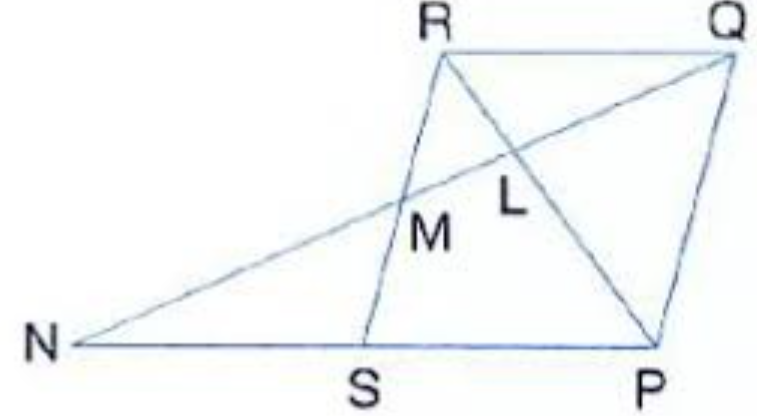In ΔPQR,PQ=PR.A is a point in PQ and B is a point in PR , so that
QR = RA = AB = BP
Find the vlaue of ∠Q.
The correct Answer is:(7717)
To solve the problem regarding triangle ΔPQR where PQ=PR and points A and B are placed such that QR=RA=AB=BP, we need to find the value of ∠Q.
1. Understanding the Triangle:
Since PQ=PR, triangle PQR is an isosceles triangle with PQ and PR as the equal sides.
Hint: Remember that in an isosceles triangle, the angles opposite the equal sides are also equal.
2. Setting the Lengths:
Let QR=x. According to the problem, we have:
- RA=x
- AB=x
- BP=x
This means that A and B are points on PQ and PR respectively, and each segment QR,RA,AB,BP is equal to x.
Hint: You can visualize this by drawing the triangle and marking the segments to see how they relate to each other.
3. Finding the Lengths:
Since A is on PQ and B is on PR, we can express the lengths of PA and PB:
- PA=PQ−QA=PQ−QR=PQ−x
- PB=PR−RB=PR−RA=PR−x
Hint: Use the property of the triangle to express the segments in terms of x.
4. Using the Isosceles Property:
Since PQ=PR, we can denote PQ=PR=k for some length k. Thus:
- PA=k−x
- PB=k−x
Hint: This shows that both segments from point P to points A and B are equal, reinforcing the isosceles nature of the triangle.
5. Finding Angles:
In triangle PQR, the angles opposite the equal sides are equal. Let ∠PQR=∠PRQ=θ. Therefore, we have:
∠Q+2θ=180∘
Rearranging gives:
∠Q=180∘−2θ
Hint: Remember that the sum of angles in a triangle is always 180∘.
6. Using the Equal Lengths:
Since QR=RA=AB=BP=x, and all segments are equal, we can deduce that triangle QRA and triangle PAB are also isosceles. This means that the angles ∠QAR and ∠PAB can be expressed in terms of θ.
Hint: Look for relationships between the angles formed by the equal segments.
7. Final Calculation:
Since QR=RA=AB=BP and they are all equal, we can conclude that:
- θ=60∘ (as all angles in an equilateral triangle are 60∘).
Therefore:
∠Q=180∘−2(60∘)=60∘
Hint: Check if the angles make sense with the properties of the triangle.
Conclusion:
Thus, the value of ∠Q is 60∘.
Since PQ=PR, triangle PQR is an isosceles triangle with PQ and PR as the equal sides.
Let QR=x. According to the problem, we have:
- RA=x
- AB=x
- BP=x
Since A is on PQ and B is on PR, we can express the lengths of PA and PB:
- PA=PQ−QA=PQ−QR=PQ−x
- PB=PR−RB=PR−RA=PR−x
Since PQ=PR, we can denote PQ=PR=k for some length k. Thus:
- PA=k−x
- PB=k−x
In triangle PQR, the angles opposite the equal sides are equal. Let ∠PQR=∠PRQ=θ. Therefore, we have:
∠Q+2θ=180∘
Rearranging gives:
∠Q=180∘−2θ
Since QR=RA=AB=BP=x, and all segments are equal, we can deduce that triangle QRA and triangle PAB are also isosceles. This means that the angles ∠QAR and ∠PAB can be expressed in terms of θ.
Since QR=RA=AB=BP and they are all equal, we can conclude that:
- θ=60∘ (as all angles in an equilateral triangle are 60∘).
Therefore:
∠Q=180∘−2(60∘)=60∘
Thus, the value of ∠Q is 60∘.
Topper's Solved these Questions
- CHAPTERWISE REVISION (STAGE 1) Book:ICSEChapter:CHAPTERWISE REVISION (STAGE 1) Exercise:Inequalities
Explore 5 Videos
- CHAPTERWISE REVISION (STAGE 1) Book:ICSEChapter:CHAPTERWISE REVISION (STAGE 1) Exercise:Mid-point and intercept theorem
Explore 11 Videos
- CHAPTERWISE REVISION (STAGE 1) Book:ICSEChapter:CHAPTERWISE REVISION (STAGE 1) Exercise:logrithms
Explore 20 Videos
- CHAPTER REVISION (STAGE 2) Book:ICSEChapter:CHAPTER REVISION (STAGE 2) Exercise:DISTANCE FORMULA
Explore 12 Videos
- CHAPTERWISE REVISION (STAGE 3) Book:ICSEChapter:CHAPTERWISE REVISION (STAGE 3) Exercise:DISTANCE FORMULA
Explore 11 Videos
Similar Questions
In ΔPQR,PQ=PR.A is a point in PQ and B is a point in PR , so that
QR = RA = AB = BP
show that :∠P:∠R=1:3
View SolutionS is any point on side QR of a ΔPQR. Show that PQ+QR+RP>2PS .
View SolutionIf Q is a point on the side SR of a triangle ΔPSR such that PQ=PR then prove that PS>PQ
View SolutionIn ΔPQR,∠Q=90∘ and QM is perpendicular to PR. Prove that :
PQ2+QR2=PR2
View SolutionIn a ΔPQR, N is a point on PR, such that QN⊥PR. If PN⋅NR=QN2, then prove that ∠PQR=90∘.
View SolutionIn ΔPQR,∠Q=90∘ and QM is perpendicular to PR. Prove that :
PQ2=PM×PR
View SolutionIn ΔPQR, Q =(0,0), PQ = 2, ∠PQR=π3 and the mid point of QR has co-ordinates (2,0) then find the centroid of triangle
View SolutionA circle is inscribed in a triangle PQR with PQ = 10 cm, QR = 8 cm and PR = 12 cm. Find the lengths QM, RN and PL.
View SolutionA circle is inscribed in a triangle PQR with PQ = 10 cm, QR = 8 cm and PR = 12 cm. Find the lengths QM, RN and PL.
View SolutionIn the figure, PQRS is a parallelogram with PQ = 16 cm and QR = 10 cm. L is a point on PR such that RL:LP=2:3. QL produced meets RS at M and PS produced at N.
Find the lengths of PN and RM.

View Solution

